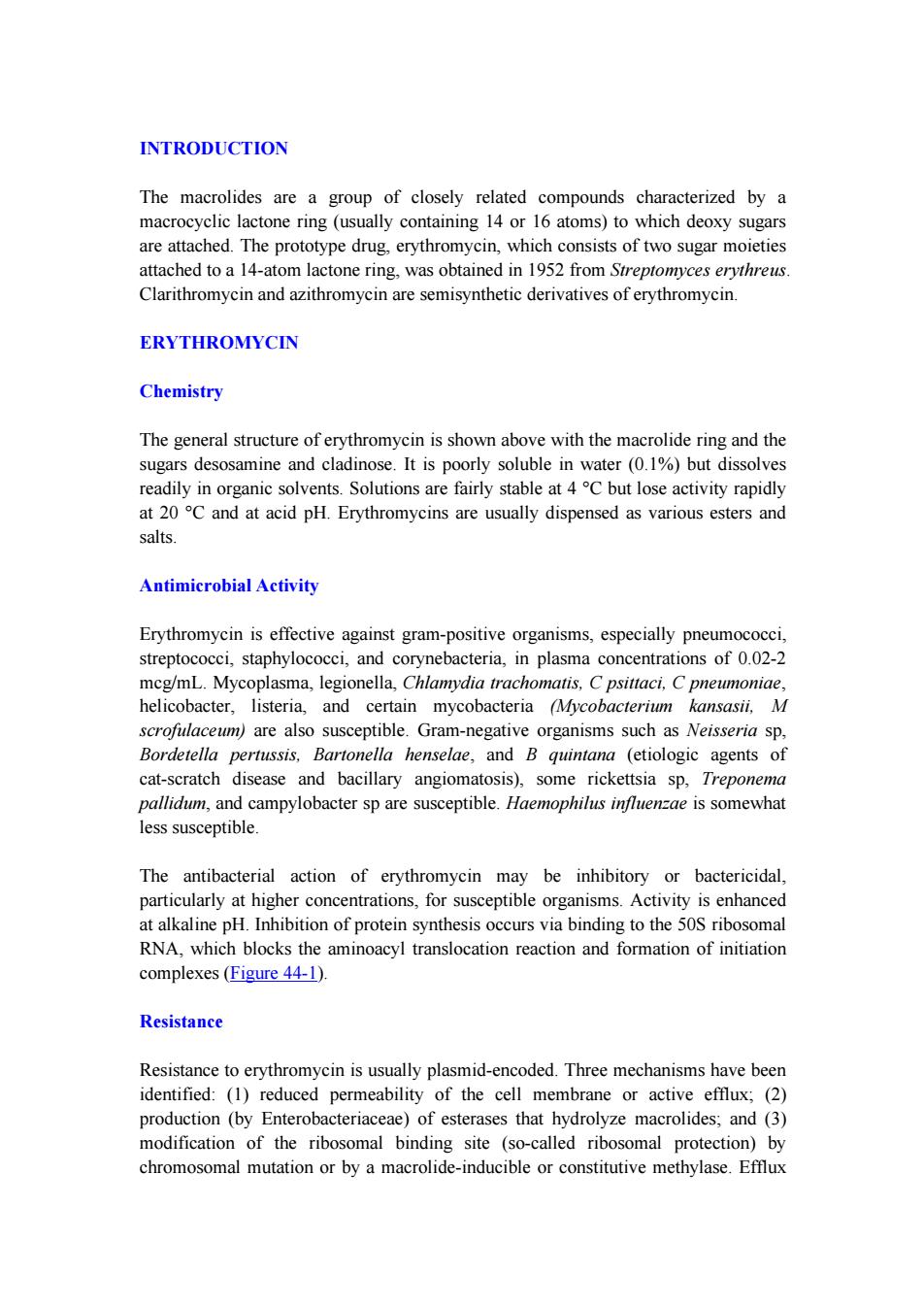正在加载图片...

INTRODUCTION The macrolides are a group of closely related compounds characterized by a macrocyclic lactone ring (usually containing 14 or 16 atoms)to which deoxy sugars are attached.The prototype drug,erythromycin,which consists of two sugar moieties attached to a 14-atom lactone ring,was obtained in 1952 from Streptomyces erythreus. Clarithromycin and azithromycin are semisynthetic derivatives of erythromycin. ERYTHROMYCIN Chemistry The general structure of erythromycin is shown above with the macrolide ring and the sugars desosamine and cladinose.It is poorly soluble in water (0.1%)but dissolves readily in organic solvents.Solutions are fairly stable at 4 C but lose activity rapidly at 20 C and at acid pH.Erythromycins are usually dispensed as various esters and salts. Antimicrobial Activity Erythromycin is effective against gram-positive organisms,especially pneumococci, streptococci,staphylococci,and corynebacteria,in plasma concentrations of 0.02-2 mcg/mL.Mycoplasma,legionella,Chlamydia trachomatis,C psittaci,C pneumoniae, helicobacter,listeria,and certain mycobacteria (Mycobacterium kansasii,M scrofulaceum)are also susceptible.Gram-negative organisms such as Neisseria sp, Bordetella pertussis,Bartonella henselae,and B quintana (etiologic agents of cat-scratch disease and bacillary angiomatosis),some rickettsia sp,Treponema pallidum,and campylobacter sp are susceptible.Haemophilus influenzae is somewhat less susceptible. The antibacterial action of erythromycin may be inhibitory or bactericidal, particularly at higher concentrations,for susceptible organisms.Activity is enhanced at alkaline pH.Inhibition of protein synthesis occurs via binding to the 50S ribosomal RNA,which blocks the aminoacyl translocation reaction and formation of initiation complexes (Figure 44-1). Resistance Resistance to erythromycin is usually plasmid-encoded.Three mechanisms have been identified:(1)reduced permeability of the cell membrane or active efflux;(2) production (by Enterobacteriaceae)of esterases that hydrolyze macrolides;and (3) modification of the ribosomal binding site (so-called ribosomal protection)by chromosomal mutation or by a macrolide-inducible or constitutive methylase.EffluxINTRODUCTION The macrolides are a group of closely related compounds characterized by a macrocyclic lactone ring (usually containing 14 or 16 atoms) to which deoxy sugars are attached. The prototype drug, erythromycin, which consists of two sugar moieties attached to a 14-atom lactone ring, was obtained in 1952 from Streptomyces erythreus. Clarithromycin and azithromycin are semisynthetic derivatives of erythromycin. ERYTHROMYCIN Chemistry The general structure of erythromycin is shown above with the macrolide ring and the sugars desosamine and cladinose. It is poorly soluble in water (0.1%) but dissolves readily in organic solvents. Solutions are fairly stable at 4 °C but lose activity rapidly at 20 °C and at acid pH. Erythromycins are usually dispensed as various esters and salts. Antimicrobial Activity Erythromycin is effective against gram-positive organisms, especially pneumococci, streptococci, staphylococci, and corynebacteria, in plasma concentrations of 0.02-2 mcg/mL. Mycoplasma, legionella, Chlamydia trachomatis, C psittaci, C pneumoniae, helicobacter, listeria, and certain mycobacteria (Mycobacterium kansasii, M scrofulaceum) are also susceptible. Gram-negative organisms such as Neisseria sp, Bordetella pertussis, Bartonella henselae, and B quintana (etiologic agents of cat-scratch disease and bacillary angiomatosis), some rickettsia sp, Treponema pallidum, and campylobacter sp are susceptible. Haemophilus influenzae is somewhat less susceptible. The antibacterial action of erythromycin may be inhibitory or bactericidal, particularly at higher concentrations, for susceptible organisms. Activity is enhanced at alkaline pH. Inhibition of protein synthesis occurs via binding to the 50S ribosomal RNA, which blocks the aminoacyl translocation reaction and formation of initiation complexes (Figure 44-1). Resistance Resistance to erythromycin is usually plasmid-encoded. Three mechanisms have been identified: (1) reduced permeability of the cell membrane or active efflux; (2) production (by Enterobacteriaceae) of esterases that hydrolyze macrolides; and (3) modification of the ribosomal binding site (so-called ribosomal protection) by chromosomal mutation or by a macrolide-inducible or constitutive methylase. Efflux